- Pakistan reintroduces Anti-Terrorism Act with preventive detention powers for military, civil forces ANI News
- NA passes ATA amendments allowing 3-month ‘preventive detention’ of terror suspects Dawn
- NA amends anti-terrorism law extending pre-trial detention period The Express Tribune
- LEAs again allowed to detain any suspect for up to 90 days The News International
- National Assembly adopts anti-terrorism (amendment) bill Aaj English TV
Blog
-
Pakistan reintroduces Anti-Terrorism Act with preventive detention powers for military, civil forces – ANI News
-
Gold extends rise on Fed rate cut hopes, softer dollar – Reuters
- Gold extends rise on Fed rate cut hopes, softer dollar Reuters
- Gold prices edge up amid Fed rate cut hopes; US-Russia talks awaited Investing.com
- Gold’s (XAU/USD) Recovers to $3350/oz After Mixed CPI Reaction. What Next? Action Forex
- Gold (XAUUSD), Silver, Platinum Forecasts – Gold Attempts To Rebound As Dollar Pulls Back FXEmpire
- Dollar weakness remains primary driver of gold prices KITCO
Continue Reading
-

Drama to challenge Essex’s ‘teeth and tans’ stereotype
Henry Godfrey-EvansBBC News, Essex
 Olly Thatcher
Olly Thatcher(From left to right) Tom the builder, Jake Erland, Tommy Davis, Jude Moore, Sonny Green and Alex Hayman A group of millennial filmmakers are looking to challenge Essex’s “teeth and tans” stereotype with an authentic working-class comedy-drama.
Cash in Hand – created by and starring people from across the county – aims to “document the essence” of Essex, “the real graft, the real chaos and the real heart”.
The team has decided to crowdfund for a pilot episode to pitch to commissioners rather than presenting a script, in an effort to retain “creative control”.
It has passed £5,000 in donations so far.
Rayleigh-based director Tommy Davis, 28, believes there is a “massive vacancy” of working class stories in UK television.
Actor Sonny Green, 30, from Southend-on-Sea, also said: “I think it was worse years ago, growing up, when certain shows did come up, and I felt like the whole of Essex got kind of blanketed into one type of person.”
 Olly Thatcher
Olly ThatcherOn set, Jude Moore is playing “Lips” and Sonny Green is playing “Kush” Mr Davis said he fell back in love with his home county when he returned from travelling.
“I was reconnecting with family spending a lot of time with the colourful whimsical people that were around Essex and I just felt there was a need to document the essence that we don’t see or haven’t seen on television, the real graft, the real chaos and the real heart of people that live in Essex,” he said.
“I grew up around lads that are like featured in the script who are full of chat, chasing dreams with empty pockets and like no real plan B.
“We want to bottle that spirit before it gets flattened and rebranded as progress, basically.”
He said the only similar example he could think of was the BBC drama White Gold, which was set in 1980s Basildon.
 Sonny Green
Sonny GreenSonny Green is a car boot sale dealer who claims to have the biggest second-hand shop in the county Cast member Mr Green is also a prolific car boot sale dealer, and previously told the BBC that Essex is full of “cheeky chappies” and wheeler dealers”.
He said a lot of the Essex dramas have been London-centric and comparable to “the end of the Central Line”.
“I don’t think we’ve necessarily seen a lot of the Southends, the Rayleighs, the Basildons, the Canvey Islands… the other parts of Essex, I feel like we’ve had a lot of kind of Loughton and Buckhurst Hill and Brentwood, but when we get deeper in you see a different story,” he said.
Producer Kit Patrick, 30, was born and raised in Wandsworth and said Essex had a definite identity to it.
“There’s a way in which people treat one another there, and I think that was really beautiful to see,” he said.
“It was really important that we keep as firm a grip on the creative drive and as firm a grip on the authenticity of the show… (it) gives us the best chance of holding on to those ideals and to that truth.”
Continue Reading
-
Abs District, Yemen: A daily fight for survival for women and girls as food pipelines dry up and funding cuts deepen – ReliefWeb
- Abs District, Yemen: A daily fight for survival for women and girls as food pipelines dry up and funding cuts deepen ReliefWeb
- Yemen faces ‘disastrous’ hunger crisis as Red Sea escalation threatens peace efforts, UN warns Arab News
- Pakistan pushes for inclusive peace process to settle ‘serious’ Yemeni crisis Associated Press of Pakistan
- Yemen must not be drawn further into war in Gaza: UN envoy Xinhua
- Yemen: ‘Regional turmoil continues to erode prospects for peace,’ Security Council hears UN News
Continue Reading
-

GDP latest: Figures expected to show growth slowed
What is GDP?published at 05:45 British Summer Time
The figures due to be published today are for the country’s GDP – or Gross Domestic Product.
It’s a way of measuring all the economic activities of companies, governments, and people in a country.
In the UK, new GDP figures are published every month by the Office for National Statistics (ONS).
The ONS measures GDP by taking into account the UK’s output, its expenditure, and its income, but this can sometimes hide important details on important aspects of living standards like inequality and living standards.
Most economists, politicians, and businesses like to see GDP growing steadily – because it means people are spending more, more jobs are being created and more tax is being paid.
But last month figures showed GDP had contracted by 0.1% in May, following a 0.3% contraction in April – meaning the economy is shrinking.
If GDP falls for two quarters in a row, this is known as a recession, which can lead to pay freezes and job losses.
- We’ve got more on how GDP is measured, and how it might affect you, in our explainer piece
Continue Reading
-

Former RCB cricketer picks his all-time Test playing XI; includes no Indians but one from Pakistan
Former Royal Challengers Bengaluru (RCB) cricketer Wayne Parnell has revealed his all-time best Test playing XI. The 36-year-old shared his selections in an interaction with CricTracker, naming former South Africa captain Graeme Smith and Australia’s Matthew Hayden as his openers.
At No. 3, Parnell picked former Australia captain Ricky Ponting, while his middle order boasts a star-studded lineup of former Proteas all-rounder Jacques Kallis, West Indies legend Brian Lara, Sri Lanka’s Kumar Sangakkara, and AB de Villiers.
In the bowling department, he opted for three pacers, including South African legends Shaun Pollock and Dale Steyn, along with Pakistan’s Wasim Akram. The lone spinner in his XI is the late Shane Warne.
Wayne Parnell’s all-time Test lineup: Graeme Smith, Matthew Hayden, Ricky Ponting, Jacques Kallis, Brian Lara, Kumar Sangakkara, AB de Villiers, Shaun Pollock, Wasim Akram, Shane Warne, Dale Steyn.
Three Indians make the cut in Wayne Parnell’s all-time ODI XI
In the same interaction, Proteas cricketer Wayne Parnell also revealed his greatest all-time ODI XI. The 36-year-old named former India legend Sachin Tendulkar and Hashim Amla as his openers. He slotted veteran Indian batter Virat Kohli at No. 3, followed by AB de Villiers at No. 4. Former Australia batter Michael Hussey and Pakistan all-rounder Shahid Afridi took the No. 5 and No. 6 spots, respectively.
At No. 7, Parnell included MS Dhoni, whom he also named as his captain. His bowling attack comprises three pace legends: the iconic Pakistani duo Wasim Akram and Waqar Younis, joined by Australian great Brett Lee. Sri Lanka’s Muttiah Muralitharan completes the XI as the lone spinner.
Wayne Parnell’s all-time ODI lineup: Sachin Tendulkar, Hashim Amla, Virat Kohli, AB de Villiers, Michael Hussey, Shahid Afridi, MS Dhoni (c), Wasim Akram, Brett Lee, Muttiah Muralitharan, Waqar Younis.
Meanwhile, Parnell was last seen in action during the 2025 World Championship of Legends (WCL), where the South Africa Champions clinched the title after defeating the Pakistan Champions in the final. He finished the tournament as the joint top bowler alongside Peter Siddle, claiming 11 scalps in seven matches at an average of 15.45 and a strike rate of 11.45.
Get real-time updates on IPL 2025, live scores, IPL Prediction, match schedule, points table,Result & squad –CSK, MI, RCB, KKR, SRH, LSG, DC, GT, PBKS
Edited by Dev Sharma
Continue Reading
-
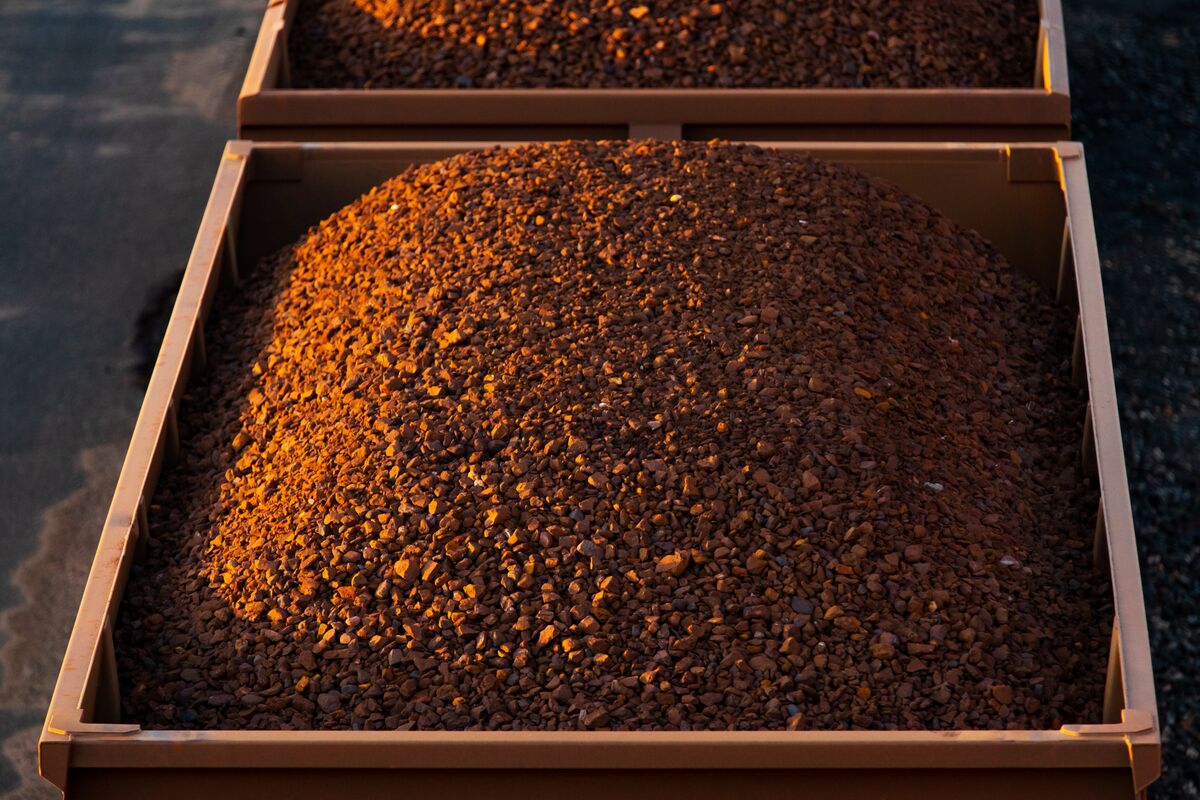
Iron Ore Falls for Second Day Ahead of Chinese Steel Output Data
Iron ore fell for a second day before the release of key Chinese data that should provide a clearer picture of curtailments to steel production in the world’s biggest metals consumer.
The steel-making ingredient fell as much as 1.8% in Asian trading on Thursday. China’s July industrial output figures, released on Friday, will show whether mills are implementing further cuts to production. The China Iron and Steel Association’s 10-day output figures, taken from a smaller sample of mills, showed a 7.4% drop in crude steel output at the end of July compared with the previous period.
Continue Reading
-
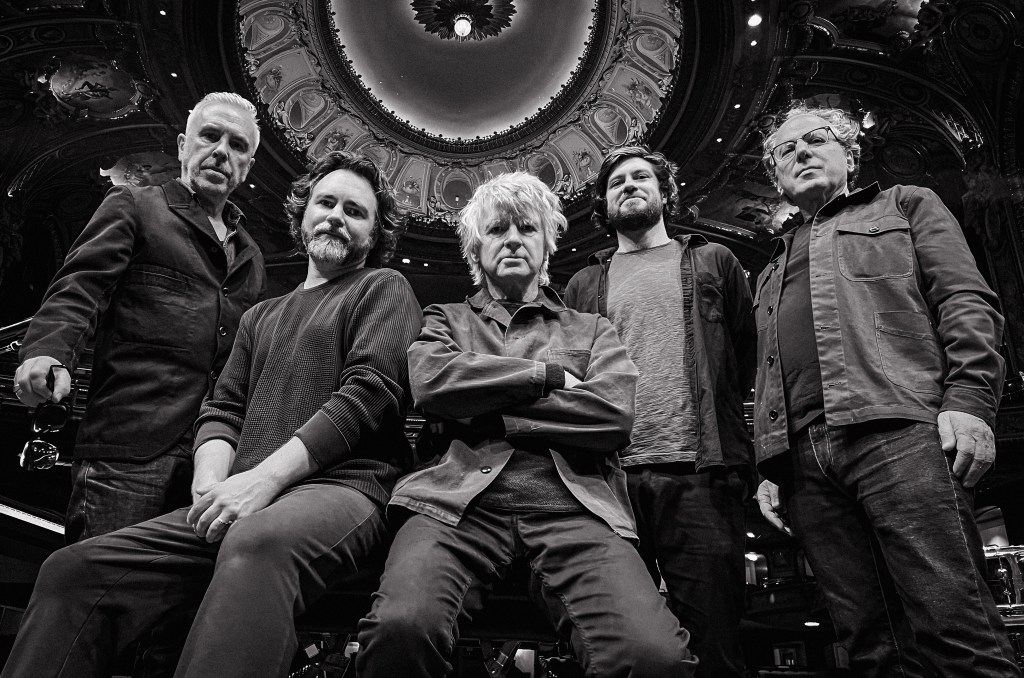
Crowded House Respond to AI-Generated Video Rumors: ‘Don’t Be Fooled’
Veteran Australian rock outfit Crowded House have been the subject of a baffling AI-generated video hoax, with the group issuing a brief statement dispelling the claims made by the clip.
Crowded House shared the video in question to their Facebook page on Saturday (Aug. 9), with the clip featuring AI renditions of TVNZ journalist Simon Dallow and frontman Neil Finn discussing the false claim the musician had fathered a child at the age of 67.
“I never thought I’d be able to become a father again,” Finn can be heard saying, albeit with an improper accent. “Honestly, I believe that chapter of my life was closed, not because I didn’t want it, but because I simply couldn’t.”
As the video unfolds, it becomes clear it was created to promote treatment for men suffering from erectile dysfunction. “For years I lived with a problem most men are too ashamed to talk about,” the AI avatar continued. “No desire, no confidence, no control. I was too embarrassed to even talk to my wife about it.”
The three-minute video concludes with the fake version of Finn even claiming that his desire to speak out in regards to his apparent plight had previously resulted in threats, adding: “I won’t stay silent because I see how men are reclaiming their lives.”
Crowded House’s response to the clip was concise, urging fans not to believe any of the claims made in the clip. “We’re not sure where this came from but please don’t be fooled,” the band wrote. “Neil’s never had trouble with erections.”
Notably, this isn’t the first time that Dallow had been involved in AI-generated video hoaxes, with a 2023 incident seeing the veteran journalist included in a fake video promoting gambling apps.
“We are seeing a proliferation of this type of scam material online and we are dealing with this content on a weekly basis,” a spokesperson for TVNZ said at the time. “These fake stories and scam advertisements are a fabrication.
“Our presenters’ images are used without permission, the quotes are made up and there is no legitimate endorsement or genuine association.”
The group’s brush with AI-generated nonsense comes just days after they announced a series of pop-up dates in their native Australia this October and November. The tour follows the band’s sold-out 2024 run in support of their eighth studio album Gravity Stairs, and marks another chapter in a storied career spanning nearly four decades.
Crowded House have sold more than 15 million records globally, with their self-titled 1986 debut spawning classics like “Don’t Dream It’s Over” and “Something So Strong.” The band has received 13 ARIA Awards, a Brit Award, and an MTV VMA, and has been streamed billions of times.
Fronted by Finn and co-founder Nick Seymour, the band’s current lineup came together in 2020 and released Dreamers Are Waiting in 2021. Finn’s 2018 stint with Fleetwood Mac introduced him to a new generation of fans before returning to lead Crowded House into a new era.
Continue Reading
-

Surface appearance of poly lactic acid due to variations in material extrusion processing parameters
The total number of PLA specimens generated was 17, with k = 3 and Co = 5. The developed DoE plan is shown in Table 3.
Table 3 Box-Behnken design of experiments plan of MEX parameters. All MEX specimens were in good condition; no layer delamination, warping, or material degradation was detected. However, as Fig. 6 shows, the color difference and surface aspects between specimens of different sets were evident through a simple visual inspection. The variations in process parameters caused the color difference. It was perceptibly apparent that the white-black shift and intensity increased with the permanence time of the material in the melt condition and the raster dimensions. As expected, a low deposition time was associated with thicker material accumulation, resulting in a well-defined deposition raster with a smaller width. The peaks of each raster had higher gray values than the surrounding valleys. On the contrary, the rasters realized with high deposition were thinner, with a larger width, and exhibited minor variations between peaks and valleys.
Fig. 6 Root mean squared height Sq and arithmetical mean height Sa were the metrics used in MountainMap to measure the surface texture, as they were not sensitive to measurement parameters such as sampling length and evaluation length28. Sq represented the root mean square of ordinate values within the defined ROI of area A, equivalent to the root mean square deviation Rq. Sa was the extension to the surface of a line’s arithmetical mean height Ra, expressing, as an absolute value, the difference in height of each point compared to the arithmetical mean of the surface. These parameters were generally used to evaluate surface roughness. The expressions Sq-Z and Sa-Z are reported below, where the subscript Z is associated with the LBCH acquisition.
$${S_{q,Z}}=sqrt {frac{1}{A}int {int {{Z^2}(X,Y)dX} dY} }$$
(1)
$${S_{a,Z}}=sqrt {frac{1}{A}int {int {left| {Z(X,Y)} right|dX} dY} }$$
(2)
The color of the specimen surface was quantitatively analyzed with Fiji and then transferred to MountainMap. Black had the lowest intensity, and white had the highest. The color is assumed to be 0 for black and 255 for white. The intensity data of each specimen was measured at each point of the image, generating an XYG cloud in which X and Y are the spatial coordinates, and G is the associated grey value. In the case of image analysis, the Z value was substituted with the G value, and the expressions Sq-G and Sa-G are
$${S_{q,G}}=sqrt {frac{1}{A}int {int {{G^2}(X,Y)dX} dY} }$$
(3)
$${S_{a,G}}=sqrt {frac{1}{A}int {int {left| {G(X,Y)} right|dX} dY} }$$
(4)
Table 4 reports the results of the Conoscan and Fiji measurements. The value variations of all response variables were significant, pointing out the MEX process’s sensitivity to the process parameters.
Table 4 Box-Behnken DoE results of surface metrics. The analysis of variance (ANOVA) was performed using designexpert (Stat-Ease inc., minneapolis, USA). the degree of freedom (df), the sum of squares (SS), mean square (MS), fisher’s value (F-value), and probability value (p-value) of each response are reported in Tables 5, 6, 7 and 8. the model was significant for all responses, with p-values ranging from 0.0010 to 0.0017. the flow rate Q was the most influential factor, followed by the nozzle temperature Tn and the fan speed F. the investigation of the ANOVA results gave an essential overview of the statistical model to use. According to the analyses of all responses, the linear model was significant, and the lack of fit was not substantial relative to the pure error. there was a high chance that the lack of fit could occur due to noise. the coefficient of determination R2 was higher than 67%, and the adq precision ratio was greater than 9.7, suggesting that the linear models were suitable for exploring and optimizing the design space
The Response Surfaces of Sq and Sa metrics are reported in Figs. 7 and 8 for the Conoscan and Fiji acquisitions.
Fig. 7 
Conoscan surface metrics with F = 75%.
Fig. 8 
Fiji surface metrics with F = 75%.
The results trends of both acquisition systems were the same for the two responses. The Sq and Sa values decreased with increased flow rate Q and nozzle temperature Tn. The contrary happened with increased flow rate Q and nozzle temperature Tn. The decrease in fan speed F caused the Sq and Sa values to be slightly reduced. The framework for the grayscale gave the same trends as the laser-based method. The primary advantage was the processing speed, which made this method suitable for online measurements.
The specimens with ID 5 (Q = 20 mm3/s, Tn = 240 °C, and F = 75%) and ID 15 (Q = 5 mm3/s, Tn = 220 °C, and F = 75%) were selected to compare the surface morphology, representing two opposite sets, respectively, with the lowest and the highest values of the surface metrics. Figure 9 shows the 5 × 5 mm² ROI of the investigated samples and the computed 3D surface topography, filtered using a Gaussian low-pass filter with a cutoff of 0.8 mm. The surface with the lowest peak heights was associated with specimen ID 5, indicating that the process parameter set used for this specimen was the best option for achieving a maximum peak height of 5 μm. The minimum error was also achieved, primarily due to the solidification conditions after deposition. The effect of the flow rate and nozzle temperature on roughness was notably more substantial than that of fan speed. On the contrary, the surface peak heights were higher for sample ID 15, reaching the maximum value of 20 μm. Moreover, the deposition rasters on the surface were more evident, with an apparent alternation between peaks and valleys. Significant differences were not found between trends of Conoscan and Fiji elaborations. The peaks and valleys of Fiji elaboration had values different from those of Conoscan, but the trends remained the same. The lower precision resulted in a coarser granularity of the Fiji surface reconstruction compared to the Conoscan resolution.
Fig. 9 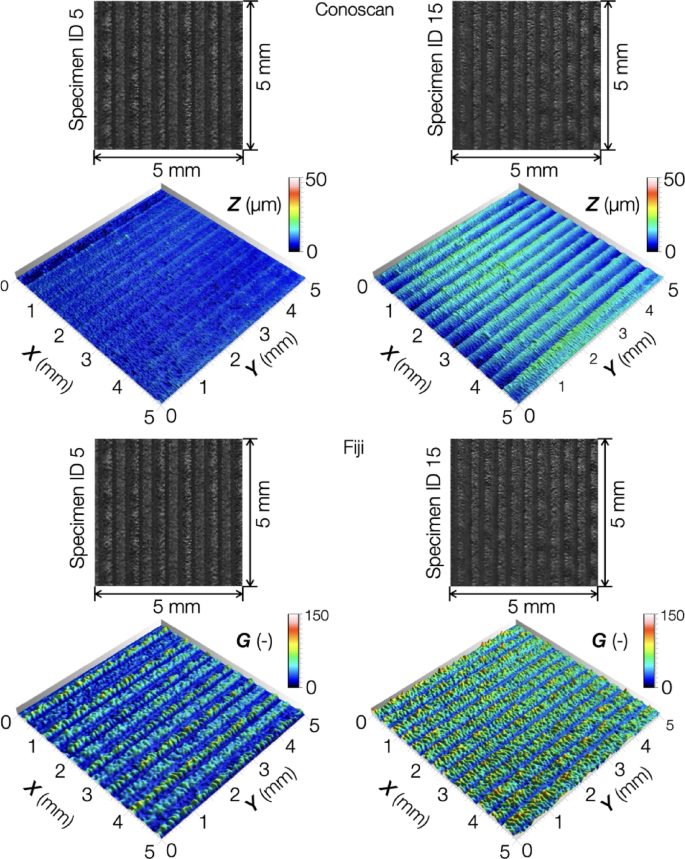
Surface of specimen ID 5 and ID 15.
The next step was to analyze the distribution of the gray value using a histogram curve. This graph displays the frequency of points with a given gray value height for specimen IDs 5 and 15, as reported in Fig. 10, working on Fiji surfaces.
Fig. 10 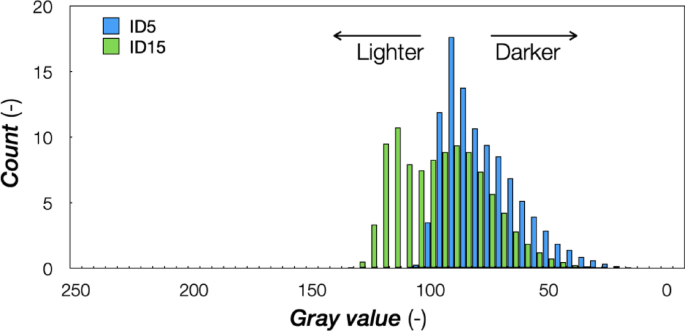
Fiji Histograms of specimen ID 5 and ID 15.
The shape of the frequency distribution was very interesting to evaluate. ID 5 was positively skewed (not symmetrical), with the longer distribution tail occurring for higher values of the measured variable, revealing that the mean, median, and mode were unequal. The symptom was associated with a smaller width of the deposition rasters with the parameter set. The regular alternation of peaks and valleys in ID 15 generated a bimodal distribution, with valleys darker than the peaks. From these observations, product surface roughness errors could be monitored, and the effects of the related process parameters could be recognized and adjusted to mitigate possible defective parts through closed-loop feedback control.
The mechanical tests were lastly performed on all specimens. The initial cross-section of each specimen was measured before testing using a digital micrometer. The maximum strain ε established for each test was 20%. All specimens broke in a fragile manner, considering the absence of a plateau after the yield point, with a low-stress drop (Fig. 11). Moreover, the elongation and tensile toughness values (as indicated by the area under the stress-strain curve) were higher than those specified in the material data sheet. Table 9 lists the tensile properties of the printed specimens, including Young’s modulus E, Tensile strength σR, and Strain at break εtb. A portion of the stress-strain curves between 5 and 20 MPa was used for the modulus calculations. The low value of 5 MPa was needed to achieve load stabilization during testing for all involved rasters. The mechanical test results revealed that the variation of response variables was more significant than 5% but lower than 10%, indicating the test repeatability compared to the median value. The stress-strain curves were reported to highlight the repeatability of the performed tests and were then analyzed statistically. The subplots of each response variable were also shown in the same figure. The degree of freedom (df), the sum of squares (SS), mean square (MS), Fisher’s value (F-value), and probability value (p-value) of each response of the ANOVA are reported in Tables 10, 11 and 12. The model was significant for all responses, with p-values ranging from 0.0002 to 0.0063. The flow rate Q was the most influential factor for E and εtb, while the fan speed F was the most important for σR.
Fig. 11 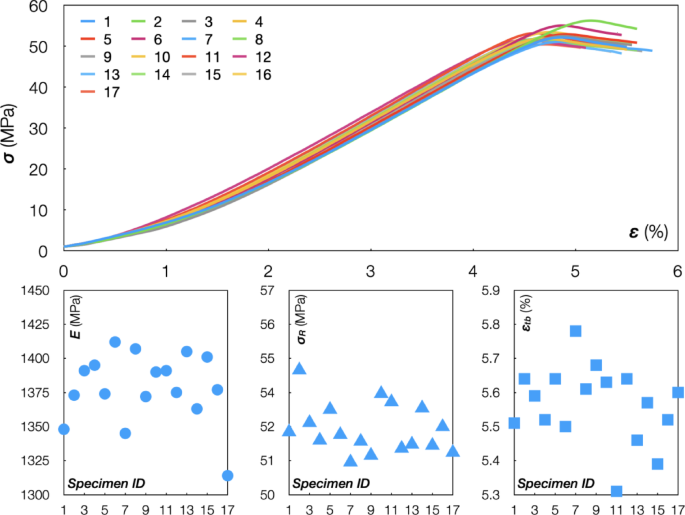
Table 9 Box-Behnken DoE results of tensile tests. The investigation of the ANOVA results gave an essential overview of the statistical model to use. According to the analyses of all responses, the linear model was significant, and the lack of fit was not significant relative to the pure error. There was a high chance that the lack of fit could occur due to noise. The coefficient of determination R2 was higher than 60%, and the adq precision ratio was more significant than 8.9. Fig. 12 
Tensile test results with F = 75% and Q = 12.5 mm3/s.
The Response Surfaces of E and σR metrics are reported in Fig. 12 for tensile test results. The specimens with IDs 13 (Q = 5 mm³/s, Tn = 240 °C, and F = 75%) and 17 (Q = 20 mm³/s, Tn = 220 °C, and F = 75%) were selected to compare their mechanical responses, representing the two sets with the lowest and highest mechanical responses. The value of the Young modulus confirmed the high performance of the specimen with ID 13 compared to the specimen with ID 17. However, the variations of σR and εtb of the two specimens were low, indicating the stability of the other mechanical responses to variations in the process parameters. For this reason, the comparison was extended to the specimens with ID 5 (Q = 20 mm3/s, Tn = 240 °C, and F = 75%) and ID 15 (Q = 5 mm3/s, Tn = 220 °C, and F = 75%), which were previously analyzed for their response to the surface metrics. For the specimen with ID 5, the E, σR, and εtb values fell within the median values, even if the surface metrics were the lowest. This behavior was justified by the consistently high raster density, which resulted in high adhesion between the printed layers, making the structure denser and thereby increasing its strength. On the contrary, the specimen with ID 15 was characterized by the lowest σR and εtb values, while the E value was the highest. The reason was to re-examine the raster configuration, which improved the specimen’s stiffness.
The analysis of the relationship between surface metrics (Sa and Sq) and mechanical properties (E, σR, and εth) was also performed. The scatter plots in Fig. 13 display the mechanical values as a function of the surface roughness values, with each point on the graph representing a single data observation. The data points for all graphs were randomly dispersed across the plot, and no discernible pattern or trend was detected. The linear regression coefficients ranging from 0.1 to 0.25 suggested the absence of a relationship between the examined variables and a large dispersion of points. The reason for this result was justified by the fact that the mechanical resistance was more influenced by the inner specimen structure (infill pattern and density) with respect to the outer surface quality29.
Fig. 13 
Correlation graphs between surface metrics and mechanical performance.
Continue Reading
-
Oil climbs on supply risks; weak fundamentals weigh – Reuters
- Oil climbs on supply risks; weak fundamentals weigh Reuters
- WTI Crude Oil Under Fire—Could Another Wave of Selling Hit Soon? Action Forex
- Oil prices recover from two month lows ahead of Trump and Putin talks WION
- Ukraine peace push stirs oil market limbo: podcast Reuters
- Oil Market Retreats: Key Implications for Investors and Business Owners Amid Supply Concerns omanet.om
Continue Reading
